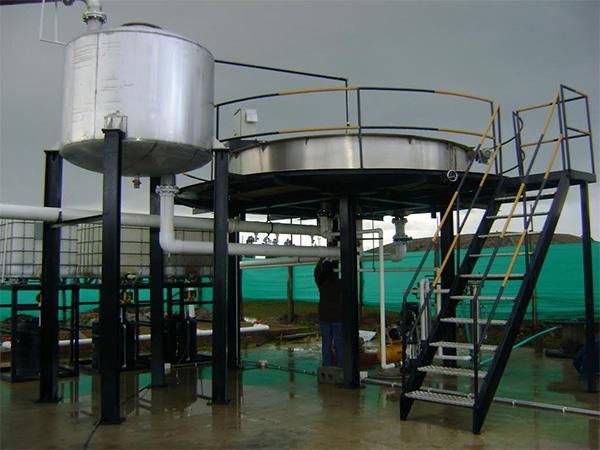Dissolved Air Floatation

Considered a reliable separation process, DISSOLVED AIR FLOATATION removes solids from liquids. The most advanced clarifier based on this principle was first used successfully in 1973 for fibre recovery in paper mills and used since then in separation processes for a range of solids and liquids.
Working Principle
The air which is dissolved under pressure in the liquid is released to atmospheric pressure in the floatation cell. The microscopic air bubbles that emerge from solution are attached to the suspended solids in the liquid. This causes to form a thick sludge on the surface of the water. A SPIRAL SCOOP, a special skimmer, removes the sludge by pouring it into the stationary centre section. From here, it is discharged by gravity for recycling or disposal.
A compact and efficient design is realized by incorporating the principle of “ZERO VELOCITY”.
A high clarification degree of 160 to 200 lpm/sqmt is attained with DAFTECH” FLOATCELL which is substantially higher than the corresponding value of conventional sedimentation save-alls.
The size and the weight of equipment are minimal with the level of water in the tank as 40 cms having a retention time of only 3 minutes.
Applications
Considering the importance of the small volume and short retention time in the case of pulp and paper industry, “DAFTECH” FLOATCELL has a distinct edge over other systems. This is critical when the sludge or water is recycled to the process and where the type of wastewater varies.
Advantages
- RETENTION TIME – Just 3 minutes.
- SPECIFIC CLARIFICATION CAPACITY – Very high (160 – 200 lpm/sq.mt.).
- PURCHASE COST – Lower than other systems of comparable performance.
- INSTALLATION COST – Low. Heavy supports not needed. Minimal load factor.
- MOBILITY – Easy. Relocation is easily accomplished.
- SPACE REQUIREMENT – Minimal. The equipment is stackable one atop another and over existing chests.
- CLEANING – Easy. Bottom is self-cleaning.
- CLARITY – High.20 – 30 ppm of filterable solids.
- SLUDGE CONSISTENCY – Thicker (2 – 3%).
Construction
Made of stainless steel SS304, the “DAFTECH” FLOATCELL is delivered in parts which can be flanged together.
Not requiring heavy foundation or structures for support, “DAFTECH” FLOATCELL has the total load factor less than 730 kg/sq.mt when filled with water.
Operation
The inner section of the central part of FLOATCELL, consisting two circular sections contains the sludge well and is fixed while the outer section rotates along with the spiral scoop at a speed synchronized with the flow. The central rotating section is where the inlet, outlet and sludge removal mechanisms are located.
Electric current fed from a rotary contact mounted on the central shaft powers the variable speed geared motor that drives the rotating elements and the scoop.
Released through a rotary joint in the centre of the tank, un-clarified water is then passed into the distribution duct that moves backward with the velocity of incoming water, thus creating ZERO VELOCITY. The setting and the floatation processes take place in this quiescent state.
Raw or recycled water is made to enter the AIR DISSOLVING TUBE tangentially at one end, pressurized to 4 – 6 bar, which is discharged at the opposite end. The water, during the short passage, inside the tube rotates repeatedly by an insert fed by compressed air.
The air is dissolved in water after thorough mixing under pressure, which is released to atmospheric pressure in the flotation cell.
Suspended solids flocculated attach themselves to the air bubbles to come to the surface forming sludge.
The floated sludge is taken by SPIRAL SCOOP, which pours it into the stationary centre section, from where it is discharged by gravity, either for recycling or disposal.
The extraction pipes connected to the moving centre section remove clarified water. Before joining the mainstream of un-clarified water, part of the clarified water will pass through the AIR DISSOLVING. The clarified water extracted from the process normally contains less than 30 ppm of suspended solids which can be recycled in the process or sewered.
Wiper blades attached to the moving distribution duct scrape the bottom and the sides of the tank, and discharge the settled sludge into the built – in sump for periodic purging.